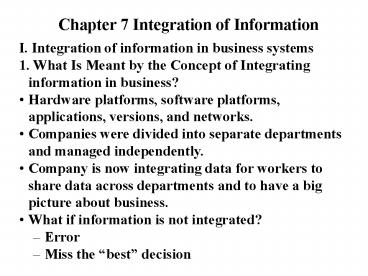Chapter 7 Integration of Information - PowerPoint PPT Presentation
1 / 7
Title:
Chapter 7 Integration of Information
Description:
Different font, displays, sound cards, and video driver - adjustment and conversion tools. ... Groupware (email, conferencing systems, collaborative authoring ... – PowerPoint PPT presentation
Number of Views:35
Avg rating:3.0/5.0
Title: Chapter 7 Integration of Information
1
- Chapter 7 Integration of Information
- I. Integration of information in business systems
- 1. What Is Meant by the Concept of Integrating
information in business? - Hardware platforms, software platforms,
applications, versions, and networks. - Companies were divided into separate departments
and managed independently. - Company is now integrating data for workers to
share data across departments and to have a big
picture about business. - What if information is not integrated?
- Error
- Miss the best decision
2
- 2. Evolution of integrated information systems
- Functional areas of business and
transaction-processing systems. - Difference between a business function and a
business process business process involves
several functional areas and functions within
those areas. - Integrated information systems are information
systems that are designed to share accurate and
timely data across functional areas. Sharing data
effectively and efficiently leads to more
efficient business processes. - Roots of ERP (Enterprise Resource Planning
System) - MRP (materials requirements planning) Plan
production and raw materials by working backward
from the sales forecast. 1960s-70s - EDI (avoid cost and delays resulting from paper
purchase order and invoice systems) - MRP II (MRP becomes a company game for various
functional areas) 1980s - ERP (an extension of MRP II) hardware,
software, and vision of integrated information
systems.
3
- II. Enterprise Recourse Planning (ERP)
- The primary method for ERP systems to integrate
data is the use of a database with consistent
data definitions. - Features and Capabilities of ERP (IBM 1972)
- A standard software that integrates business
functions such as accounting, human resources,
purchasing/logistics, sales, production planning,
and so forth. - Data to be processed interactively and to be
available in real time. - Work with data on a computer screen, and not with
printed output.
4
- III. Integrating information through networking
- 1. What role is played by networks in integrating
information in business? - The means to share data and to integrate
information across the entire company or even the
entire world (Internet). - The World Wide Web (WWW) technology has been
integrated into new operating systems and
application software. Therefor, it is easier to
share data through Web sites with users inside
and outside the company. - Example In PowerPoint, Save as HTML command
under File menu.
5
- 2. What are problems with sharing information and
solutions? - Different version of software - conversion tools
- Different font, displays, sound cards, and video
driver - adjustment and conversion tools. - Access and network paths switches for speed.
- Transmission time - data compression and
broadband for speed. - Concurrency problem - tracking multiple changes
and lock out users.
6
- 3. Groupware and Tools for Teamwork
- Networks
- Conferencing systems
- Collaboration tools (tracking changes, linked
documents) - Coordination systems
- GDSS is a type of DSS that integrates
- Groupware (email, conferencing systems,
collaborative authoring systems, coordination
systems) - DSS capability
- telecommunications
7
- IV. Data Warehouse
- It contains copies of transaction data rather
than the original transaction - Transactional data from a variety of sources is
specifically formatted - Transactional data is specifically structured to
facilitate the formation of queries and further
analysis - A data warehouse can be normalized or
denormalized - The purpose of the data warehouse is query,
analysis, and reporting - Making decision vs. post-decision monitoring
- (Marakas, G.M. 2003, Modern Data Warehousing,
Mining, and Visualization)































